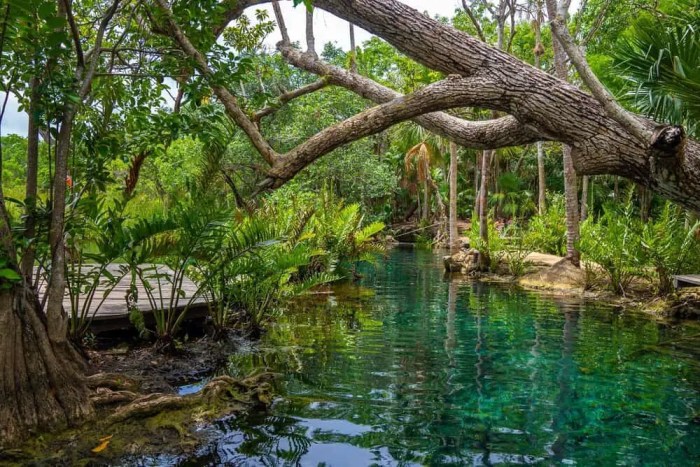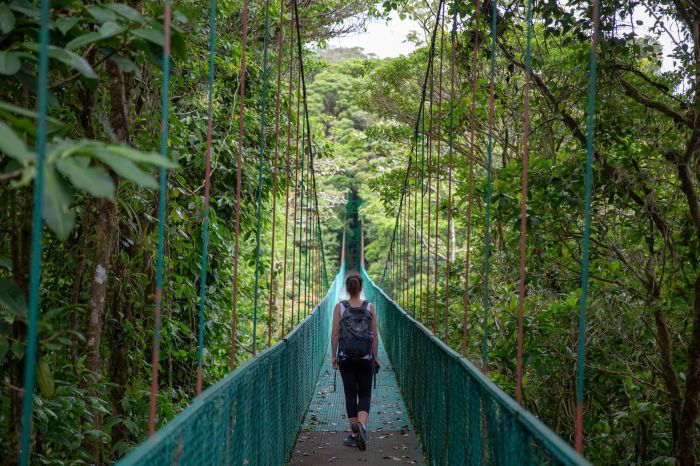As the world awakens to the importance of sustainability, the travel industry is transforming, giving rise to a new era of sustainable travel destinations. These destinations prioritize the preservation of the environment, support local communities, and promote cultural immersion, offering travelers a transformative and responsible way to explore the world.
Sustainable tourism practices not only benefit the planet but also create a positive impact on local economies and communities. By choosing destinations that embrace sustainability, travelers can contribute to a more sustainable future while enriching their travel experiences.
Sustainable Practices and Destinations: Sustainable Travel Destinations

Sustainable tourism practices are becoming increasingly important for local communities and the environment. When tourism is done sustainably, it can help to preserve natural resources, protect cultural heritage, and support local businesses.
There are many different ways to make tourism more sustainable. Some of the most common practices include:
- Using renewable energy sources
- Reducing waste and pollution
- Protecting wildlife and habitats
- Supporting local businesses
- Educating tourists about sustainable practices
There are many different destinations around the world that have adopted sustainable tourism practices. Some of the most popular examples include:
- Costa Rica
- Iceland
- New Zealand
- Bhutan
- Switzerland
These destinations have all shown that it is possible to have a thriving tourism industry while still protecting the environment and supporting local communities.
Benefits of Sustainable Tourism
There are many benefits to sustainable tourism, both for local communities and the environment. Some of the most notable benefits include:
- Economic benefits: Sustainable tourism can help to create jobs, boost local economies, and support small businesses.
- Environmental benefits: Sustainable tourism can help to protect natural resources, reduce pollution, and conserve wildlife.
- Social benefits: Sustainable tourism can help to preserve cultural heritage, promote understanding between different cultures, and support local communities.
Sustainable tourism is a win-win for everyone involved. It can help to create a more prosperous, equitable, and sustainable world.
Case Studies of Successful Sustainable Tourism Initiatives, Sustainable travel destinations
There are many different case studies of successful sustainable tourism initiatives around the world. Some of the most notable examples include:
- The Great Barrier Reef Marine Park in Australia: This marine park is one of the most successful examples of sustainable tourism in the world. The park has implemented a number of measures to protect the reef, including limiting the number of visitors, banning certain activities, and educating tourists about the importance of the reef.
- The Galapagos Islands in Ecuador: The Galapagos Islands are a unique and fragile ecosystem. The Ecuadorian government has implemented a number of measures to protect the islands, including limiting the number of visitors, requiring tourists to stay on designated trails, and banning the introduction of non-native species.
- The Maya Biosphere Reserve in Guatemala: The Maya Biosphere Reserve is a large protected area that is home to a number of endangered species. The reserve has implemented a number of sustainable tourism initiatives, including working with local communities to develop ecotourism businesses.
These are just a few examples of the many successful sustainable tourism initiatives that are happening around the world. These initiatives are helping to protect the environment, support local communities, and create a more sustainable future for all.
Eco-Friendly Accommodation

Eco-friendly hotels and resorts prioritize sustainable practices to minimize their environmental impact. These establishments adopt measures such as energy efficiency, water conservation, waste reduction, and the use of eco-friendly materials.
Features of Eco-Friendly Hotels and Resorts
– Energy-efficient lighting and appliances
– Water-saving fixtures and low-flow toilets
– Use of renewable energy sources, such as solar and wind power
– Sustainable building materials, such as recycled wood and bamboo
– Waste reduction programs, including composting and recycling
– Organic and locally sourced food options
– Educational programs for guests on sustainable practices
Examples of Sustainable Accommodation Options
– Six Senses Resorts and Spas: With properties worldwide, Six Senses focuses on sustainability, offering eco-villas and treehouses built with local materials and powered by renewable energy.
– Bawah Reserve in Indonesia: This private island resort uses solar power, collects rainwater, and supports local conservation efforts.
– Hotel Verde in Costa Rica: Certified as carbon neutral, this hotel features energy-efficient design, a rooftop garden, and a water filtration system.
Importance of Energy Efficiency and Water Conservation in Tourism
Energy efficiency and water conservation are crucial for sustainable tourism. Reducing energy consumption helps mitigate greenhouse gas emissions, while conserving water resources ensures their availability for future generations. By adopting eco-friendly practices, accommodation providers can reduce their environmental footprint and contribute to the preservation of natural ecosystems for both tourists and local communities.
Responsible Transportation

Sustainable transportation options minimize environmental impact while allowing travelers to explore destinations responsibly.
Air travel, a significant contributor to greenhouse gas emissions, can be replaced with eco-friendlier alternatives like rail or bus travel, especially for shorter distances. Electric or hybrid vehicles, along with ride-sharing and public transportation, reduce carbon footprint. Consider walking or cycling for short distances to experience the destination intimately.
Tips for Reducing Carbon Footprint while Traveling
* Opt for direct flights and avoid layovers to reduce fuel consumption.
* Pack light to minimize aircraft weight and fuel usage.
* Choose airlines with fuel-efficient aircraft and carbon offset programs.
* Offset carbon emissions by supporting reforestation or renewable energy projects.
* Travel during off-peak seasons to reduce crowds and emissions.
Cultural Immersion and Local Support

In sustainable tourism, immersing oneself in the local culture and supporting local businesses are crucial aspects. It fosters cultural preservation, understanding, and economic empowerment.
As the awareness of sustainable travel grows, families are increasingly seeking out destinations that prioritize environmental conservation and community well-being. These destinations not only offer unforgettable experiences but also contribute to preserving the planet for future generations. To discover the best family vacation spots that embrace sustainability, consider exploring eco-friendly accommodations, engaging in local cultural activities, and supporting businesses that prioritize ethical practices.
Tourism can act as a catalyst for cultural preservation by providing incentives for locals to maintain their traditions, arts, and crafts. Visitors can engage in authentic cultural experiences, such as attending traditional festivals, learning local customs, and supporting local artisans.
Sustainable travel destinations promote environmental conservation and local economic development. The United States offers many such destinations, including national parks and hiking trails. For an unforgettable outdoor adventure, consider exploring the best hiking trails in the US. These trails traverse breathtaking landscapes, showcasing the country’s diverse natural beauty while supporting sustainable travel practices.
Examples of Destinations Offering Immersive Cultural Experiences
- Morocco: Immerse yourself in the vibrant souks of Marrakech, explore the ancient medina of Fez, and witness traditional Berber culture in the Atlas Mountains.
- Peru: Discover the ancient Incan ruins of Machu Picchu, visit the floating islands of Lake Titicaca, and experience the colorful traditions of Cusco.
- Thailand: Visit bustling temples in Bangkok, learn traditional Thai cooking in Chiang Mai, and experience the unique hill tribe culture in the north.
Conservation and Wildlife Protection

Sustainable travel destinations prioritize the preservation of wildlife and their habitats. They implement responsible wildlife tourism practices and encourage ethical animal interactions to minimize impact on sensitive ecosystems.
Responsible wildlife tourism involves observing animals in their natural environment without disturbing their behavior or causing harm. It supports conservation efforts by generating revenue for wildlife protection and habitat management.
Guidelines for Minimizing Impact
- Maintain a safe distance from wildlife and avoid approaching them too closely.
- Never feed wild animals, as this can disrupt their natural feeding habits and make them dependent on humans.
- Stay on designated trails and avoid venturing into sensitive areas.
- Use binoculars or zoom lenses to observe wildlife from a distance.
- Minimize noise and avoid using flash photography, as it can disturb animals.
- Respect wildlife closures and seasonal restrictions to avoid disrupting breeding or nesting.
- Report any illegal activities or sightings of injured animals to park rangers or authorities.
Certifications and Standards
Sustainability certifications and standards provide a framework for tourism businesses to demonstrate their commitment to responsible practices. These certifications offer travelers a way to identify businesses that align with their values and support sustainable tourism.
Certification programs typically involve rigorous audits and assessments to ensure that businesses meet specific criteria. The benefits of certification include enhanced reputation, increased customer loyalty, and improved access to markets that prioritize sustainability.
Reputable Certification Programs
- Green Globe: A global certification program that assesses businesses based on environmental, social, and economic sustainability criteria.
- EarthCheck: An Australian-based program that focuses on sustainable tourism practices in hospitality, events, and destinations.
- LEED (Leadership in Energy and Environmental Design): A widely recognized certification for buildings that meet high standards of energy efficiency and environmental performance.
Future Trends and Innovations

The future of sustainable travel is bright, with emerging trends and innovative technologies promising to enhance the sustainability of the industry. These advancements are expected to revolutionize the way we travel, making it more environmentally friendly, socially responsible, and economically viable.
Sustainable travel destinations offer an opportunity to explore breathtaking natural wonders while minimizing our impact on the environment. Whether you’re planning a relaxing beach holiday, don’t forget to pack sustainably. Check out our beach holiday packing list for tips on packing eco-friendly essentials.
By choosing reusable items and supporting local businesses, we can ensure that these destinations remain pristine for generations to come.
One key trend is the growing adoption of renewable energy sources in the tourism sector. Hotels, airlines, and other travel businesses are increasingly investing in solar, wind, and geothermal energy to reduce their carbon footprint. Electric vehicles are also becoming more popular, offering a cleaner alternative to traditional fossil fuel-powered vehicles.
Technology and Sustainability
Technology is playing a vital role in promoting sustainability in travel. Mobile apps and online platforms are making it easier for travelers to find and book sustainable accommodations, tours, and activities. These platforms also provide information on the environmental and social impact of different travel options, empowering travelers to make informed choices.
Artificial intelligence (AI) is another emerging technology that is expected to have a significant impact on sustainable travel. AI can be used to optimize energy consumption, reduce waste, and improve the efficiency of transportation systems. For example, AI-powered systems can monitor energy usage in hotels and adjust lighting and heating/cooling systems to reduce consumption.
The Future of Sustainable Tourism
The future of sustainable tourism is promising, with increasing demand from travelers for environmentally and socially responsible travel options. Destinations that embrace sustainability will be well-positioned to attract tourists and generate economic benefits while preserving their natural and cultural heritage.
As the industry continues to evolve, it is essential for stakeholders to collaborate and share best practices. Governments, businesses, and travelers all have a role to play in creating a more sustainable future for travel.
Wrap-Up

Sustainable travel destinations are not just a trend; they represent a shift towards a more responsible and fulfilling way of exploring the world. As travelers become increasingly aware of the environmental and social impact of their choices, the demand for sustainable destinations will continue to grow.
Embracing sustainable travel destinations is not about sacrificing comfort or experiences; it’s about making conscious choices that preserve the beauty of our planet for generations to come while creating meaningful connections with local cultures and communities.
User Queries
What are the benefits of sustainable tourism?
Sustainable tourism benefits the environment by reducing pollution, protecting wildlife, and preserving natural resources. It also supports local communities by creating jobs, promoting cultural understanding, and fostering economic development.
How can I identify sustainable travel destinations?
Look for destinations that have implemented sustainable practices, such as energy efficiency, water conservation, waste management, and support for local businesses. Many destinations also have sustainability certifications, such as Green Globe or LEED, which provide assurance of their commitment to sustainability.
What are some tips for reducing my carbon footprint while traveling?
Choose eco-friendly transportation options, such as trains or buses, over air travel whenever possible. When flying is necessary, consider carbon offsetting programs to mitigate your impact. Pack light to reduce fuel consumption, and stay in accommodations that prioritize energy efficiency.